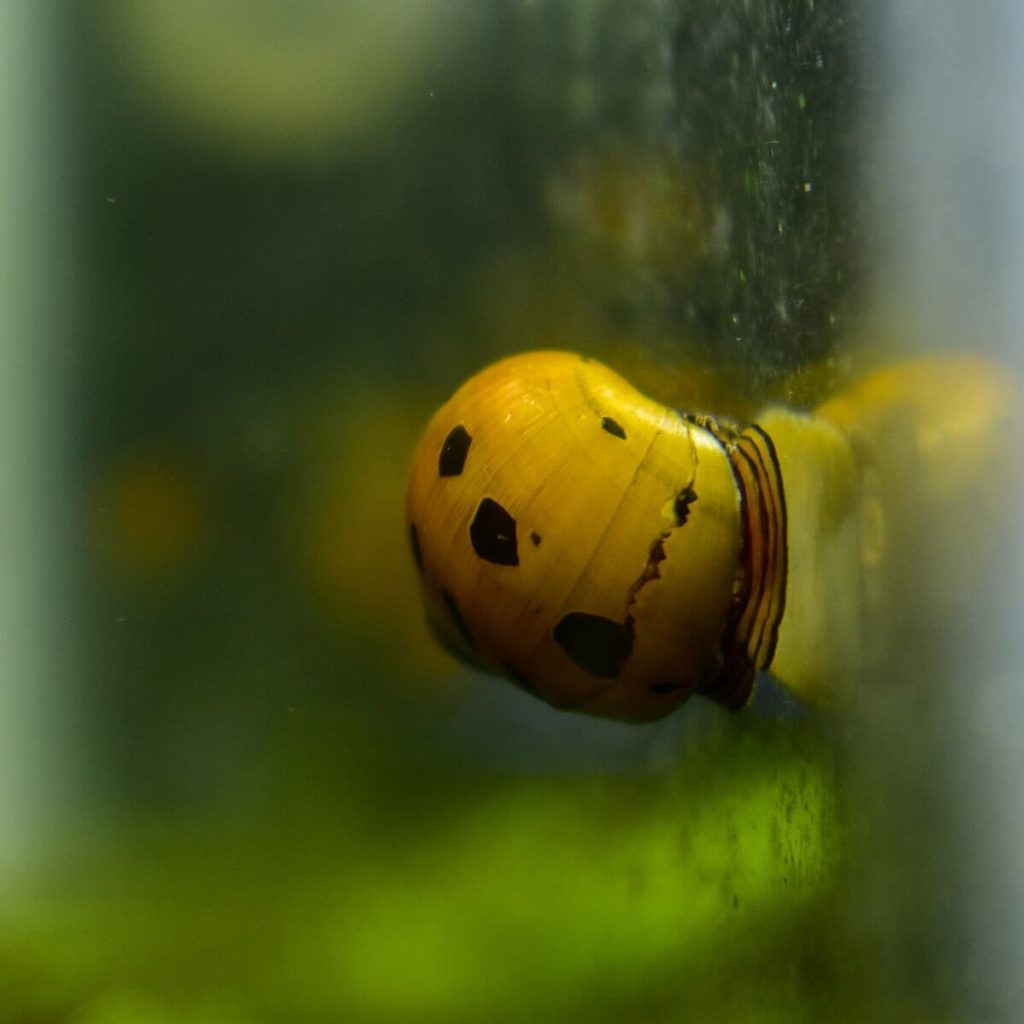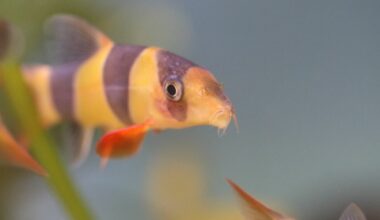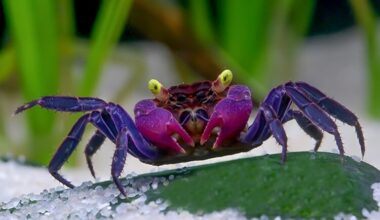Nerite snails are one of our favorite aquarium critters out there. They’re cute and busy little guys that bring a handful of benefits to your freshwater tank.
First, nerite snail care is a piece of cake. Even if you’ve never had a tank before and are still figuring everything out, these animals will be the least of your worries.
They’re also very flexible when it comes to the kind of tank setup you use them in. They mind their business and don’t need much room to thrive, which saves you time planning out the perfect home.
Oh, and did we mention the algae-eating?
Nerite snails love to snack on algae that grows in your tank. This will help keep your tank clean without any extra effort on your part!
And lastly, we think they’re pretty darn fun to watch. It’s cute to see these little things methodically work their way around the tank looking for algae to eat (we like the patterns on their shells too).
So now that we’ve sold you on the benefits of owning these critters, let’s get into the meat of the guide. In it, we’ll cover the essentials of nerite snail care and everything you can do to ensure that they live happy and comfortable lives.
Table of Contents
Species Summary
Nerite snails (neritina natalensis) can be found in a mixture of locations both in freshwater and saltwater. Saltwater varieties are more commonly found on the coast of the Pacific Ocean and sometimes drift into the Caribbean as well.

It took scientists a while to properly identify these types of snails in certain areas because some of them look very similar to different species. Not only that, but freshwater snails can be found on the Indian Ocean side of Africa. You can see how this caused a lot of confusion!
The nerite snail comes from the large Neritidae family. There are just under 250 species that make up this family and the vast majority of these snails hug the coastline of whatever area they occupy.
These snails are gentle and spend most of their time looking for algae to eat (both in the wild and in captivity). While they aren’t exactly picky when it comes to their scavenging, this is what they’ve become known for in the aquarist community.
Lifespan
The average nerite snail lifespan is somewhere between one and two years. It’s very uncommon for them to live longer than a couple of years (no matter how well you care for them).
With that being said, poor living conditions will definitely shorten the lifespan of your nerite snails. No matter how long your animals live or how much they cost, you should do everything you can to help them live happy and healthy lives.
Appearance
Nerite snails look pretty much like a regular aquatic snail. There isn’t anything that stands out and makes you go “whoa” unlike some other gastropods when it comes to their anatomy.
With that being said, some of the patterns and colors you’ll see on their shells are quite pretty! These tend to vary based on the different types of nerite snails that are out there, so it’s worth exploring that a bit before we move on to the care section of this guide.
Types Of Nerite Snails
There are many different types of nerite snails that you can get for your aquarium. Each of the popular varieties has its own patterns and colors, which can make for a very pretty tank if you mix and match enough of them.
Let’s take a closer look at each of the main types of nerite snails and what they look like.
Zebra Nerite Snail
The zebra nerite snail is one of the most popular variations you can get. It gets its name from the distinct stripes that cover its shell. These stripes are typically black but there are also plenty of cases where the stripes have been different colors as well.
Horned Nerite Snail
The horned nerite snail is probably our favorite type on this list. They typically have a couple of yellow and black rows on their shells with a few horns protruding along a color line. This gives them a really unique look that adds a bit of flare compared to other snails.
We highly recommend the horned nerite snail if you’re looking to mix things up a bit.
Tiger Nerite Snail
The pattern on the shells of tiger nerite snails is hypnotizing to look at. The base of their shell is yellowish-orange and almost looks like a round piece of polished wood. On top of this, there are usually a few rows of repeating black mini-stripes.
Black Racer Nerite Snail
The black racer nerite snail has a dark understated pattern that we absolutely love. They look like a dark piece of aged wood with repeating “grains” that work their way back across the shell.
Red Racer Nerite Snail
If you’re looking for a colorful addition to your tank, the red racer nerite snail is a perfect choice. These little critters are bright yellow or red and have a thick patterned stripe that runs down the middle of their shell.
This stripe typically has a repeating series of “arrows” that make this snail live up to its name.
Olive Nerite Snail
The olive nerite snail looks exactly like its name implies, like a little olive! The color is spot on and the diminutive size of these animals makes it very similar at first glance. You’ll notice that the coil of their shell has a couple of dark swirling lines, but that’s about the only difference!
Size
The typical size of a nerite snail is about one inch in diameter. This number can be smaller if they’re living in suboptimal living conditions, but if you’re taking good care of them it’s what you can expect.
Nerite Snail Care
Nerite snail care is pretty hard to mess up. These little critters are about as low-maintenance as it can possibly get!

Despite this, we always recommend reading up on the best ways to take care of any life in your tank (no matter how easy it seems). It’s our feeling that if you want to become a truly experienced aquarist you should have a deep understanding of all the inhabitants that live in your aquarium, and how they interact with each other.
Tank Size
The minimum tank size for a nerite snail is a 10 gallon tank. This is the recommended size for one nerite snail and should be increased if you plan on adding more. Simply add an additional five gallons for each extra snail you plan on adding to the mix.
Some aquarists express confusion when hearing about the required tank size for nerite snails. They assume that you can simply add a handful to a tank of any size and be good to go.
Here’s where they’re wrong:
While nerite snails can absolutely function and be productive algae eaters in a cramped environment, it’s the bio-load that you have to worry about. Despite their small size, nerite snails still create waste which will eventually impact the bio-load of their small tank. Once this happens you have a problem.
Water Parameters
Having the ideal water parameters are just as important for nerite snails as any other aquatic life form. If you want them to help you out by eating algae, you should help them out too!
Some people are a little surprised when they find out that the water parameter ranges for nerite snails are a little tight. These aren’t an animal that you can throw into any condition and expect them to live! Sure, they’re hardy and easy to care for but that’s assuming they’re in the optimal conditions.
- Water temperature: 72°F to 78°F is the sweet spot
- pH levels: You should be fine anywhere in the 7-8.5 range. While a lot of guides online recommend very tight ranges of pH, that’s overkill.
- Water hardness: 6-12 dH
What To Put In Their Tank
It’s important to do the best you can when it comes to mimicking their natural habitat. As we’ve established, nerite snails can be found on the coast. If you use that as a starting point, you can quickly figure out what should be included in their tank.
Author Note: Coastlines are full of many rocks, nooks, and crannies. This means you’ll want to make sure your nerite snails have plenty of places to hide and get some privacy from the rest of the tank.
We recommend rocks for this since they will accumulate algae over time and give your snails a close, convenient snack. You can also use driftwood or other forms of decorations as well to give them a bit of variety.
It’s also very important to make sure they have the proper substrate. Snails are very soft and delicate on their underside, so hard substrate that could scratch them isn’t a good idea.
Instead, go with a sandy substrate if you want to maximize their comfort. This will allow them to easily move around your tank (as easily as snails can move that is) without the risk of a cut.
Potential Diseases
Nerite snails are pretty tough animals, but there are a couple of diseases/illnesses you should keep an eye out for.
The most common disease is something called oedema. This is a condition where the snail’s fluid balance becomes disturbed and results in extreme swelling.
Unfortunately, it can be hard to figure out the cause of oedema and your only option is to wait and see if things improve. This is a condition that typically plagues older snails though, so if yours are fairly young then this likely won’t be an issue.
You should also use their shells as a way to monitor for any potential diseases or illnesses. Like most aquatic life, any white spots are usually a cause for concern.
For aquarium snails, this usually means that there’s a parasite problem that needs to be addressed. The severity of the parasite will obviously impact how effective treatment is, but here’s what you should do:
- Bring up the salinity in their tank to a specific gravity of 1.003
- If that doesn’t clear things up in a few days you should think about quarantining the affected snails
Food & Diet
As you’ve probably guessed by now, the main nerite snail food source is algae. They love it!
This means it’s important to try and facilitate some algae growth in your tank so they can move and eat how they would naturally. When you have enough algae in your aquarium, your nerite snails will roam the tank and glass munching on it endlessly.
Live rocks are a great way to provide a food source for your snails. Not only will they naturally accumulate algae on their surface over time, but your snails will also be able to use them as a hiding place.
If you think there isn’t enough algae growth in your tank to support your nerite snails you can use algae wafers to solve this problem. This is our favorite method because it’s cheap, easy, and effective.
Author Note: As always, make sure you’re not overfeeding your nerite snails. This can lead to a number of health issues (some worse than others).
Behavior & Temperament
It’s kind of funny writing a section about snail temperament because there really isn’t much to report. Nerite snail care is about as easy as it gets when it comes to dealing with their behavior.
Nerite snails are very mellow and peaceful creatures. Most of the time you can find them slowly working their way around your aquarium snacking on algae. They won’t bother or even interact with the other life in your tank, so you never have to worry about them causing trouble.

One thing that’s worth noting about their behavior is that they’ll sometimes hunker down out of the blue. This can occur anywhere and will sometimes trick owners into thinking something is wrong with their snail.
This random resting period will usually end after a couple of days, but keep an eye on them to play it safe. If anything looks odd about their appearance while they’re doing this then they might be sick.
Recommended Tank Mates
When it comes to tank mates, you’re mostly looking for animals that won’t pick on your snails or try to eat them. You see, nerite snails are about as peaceful as it gets (even if they were aggressive they wouldn’t physically be able to attack anything).
Some of the best tank mate options are other nerite snails, shrimp (ghost, cherry shrimp, and Amano being three common choices), and mellow fish.
Some of our favorite fish to keep with nerite snails are:
You’ll want to avoid fish like goldfish, cichlids (of course) and snail eaters like crayfish. Pretty much anything that will actively seek out your snails as a source of food or aggressive fish that treat them as an easy target.
Can Nerite Snails Live With Betta Fish?
This is a common question that we see in forums all the time. Fortunately, betta fish are a suitable tank mate for nerite snails. You’ll want to keep an eye on them since some of the water parameters don’t match up perfectly, but you should be fine!
Nerite Snail Breeding
Nerite snail breeding is a topic that is full of misinformation and confusion. It’s funny because other than breeding everything about this creature is very straightforward!
The source of the confusion comes from the fact that many people say nerite snail eggs can be bred in a freshwater aquarium, but the larvae need saltwater to survive. This has led to a lot of differing advice in the aquarium hobbyist community when it comes to these snails.
The safest way to handle nerite snail breeding is to slowly transition them to a tank with brackish water (sort of a hybrid between saltwater and freshwater) before breeding begins. This will not only help encourage the mating process but it will make things habitable for the larvae as well.
Other than that, there aren’t many things you can do to initiate the mating process. This can be frustrating for some which is why so many people abandon the process. You just have to be patient and let them do things on their terms.
Unlike a lot of other snails, female nerites lay eggs that the males then fertilize. They don’t do much with the eggs after this process is done and after 12-16 days the larvae should be formed and ready to go!
Conclusion
Nerite snail care is about as easy as it gets. These little critters are a joy to keep and don’t require much extra effort on your part at all.
Personally we’re huge fans of watching them inch their way around the aquarium and look for algae. It’s also fun to see them climb onto the glass so you can observe their tiny mouths at work!
If you’re looking for an awesome snail to add to your tank we can’t recommend them enough. They come in a bunch of different color varieties as well so they’re a great way to add some variety to the look of your aquarium too.
If you have questions about nerite snails or have suggestions on ways we can improve this care guide we would like to hear from you. Providing the best information possible is our entire mission, and we love getting feedback from the aquarium community.

